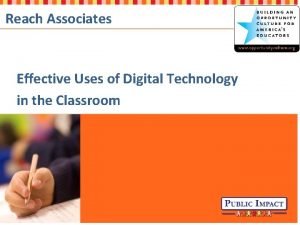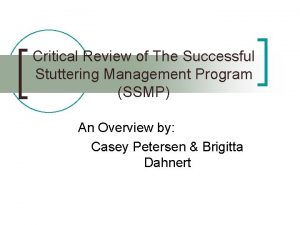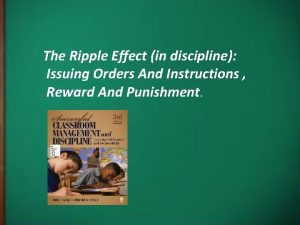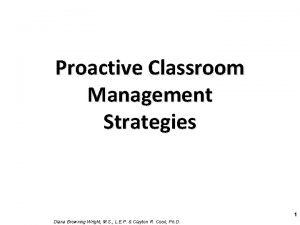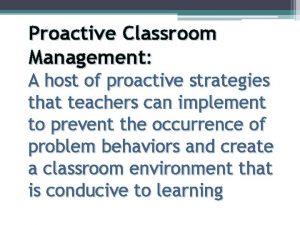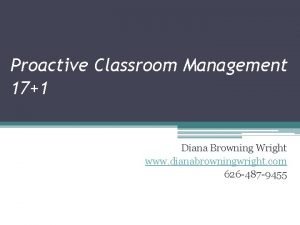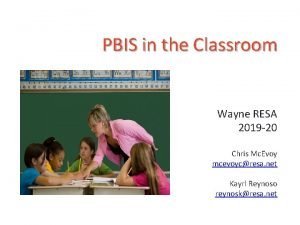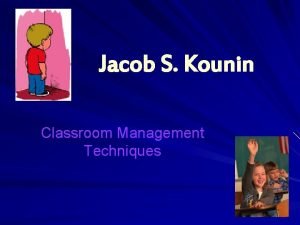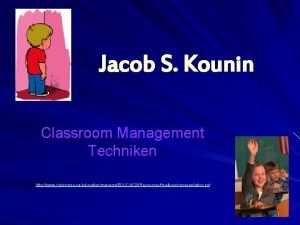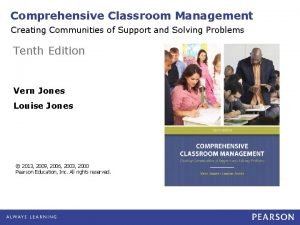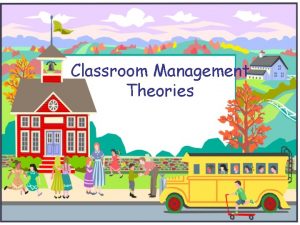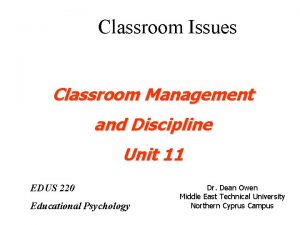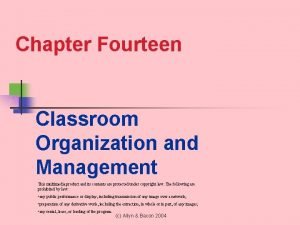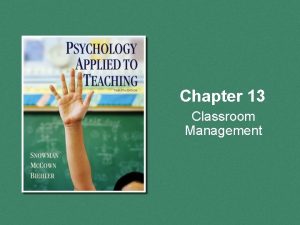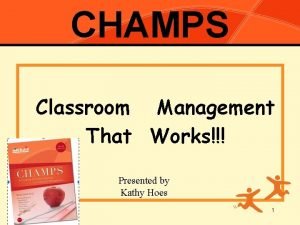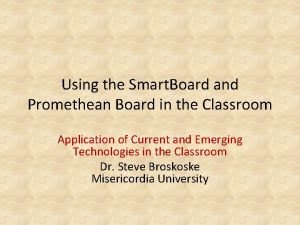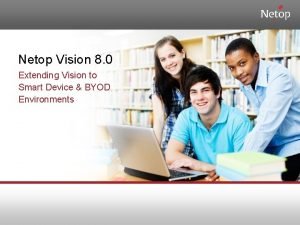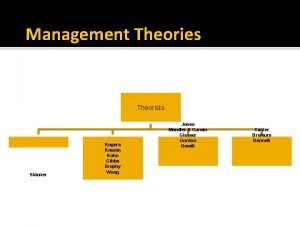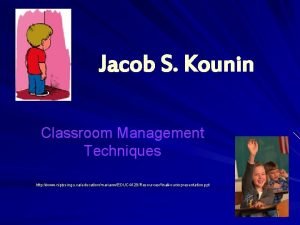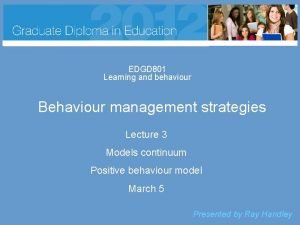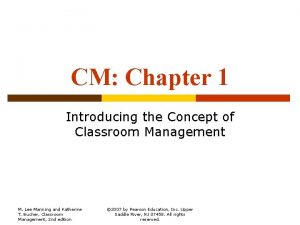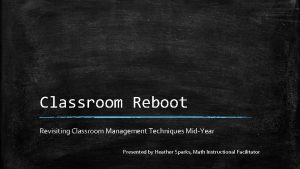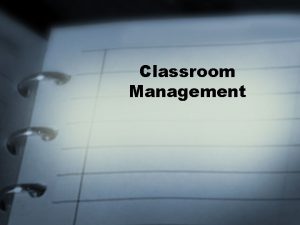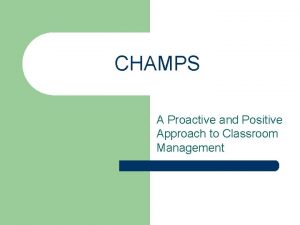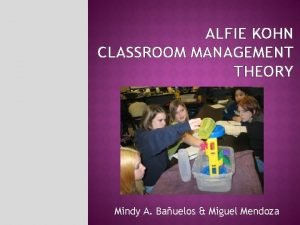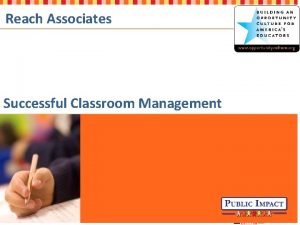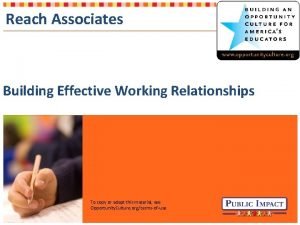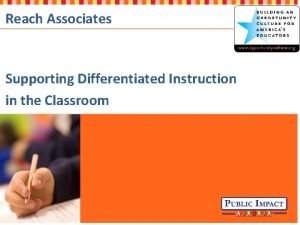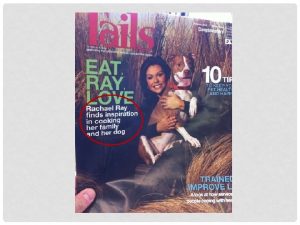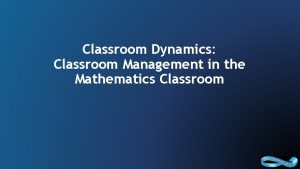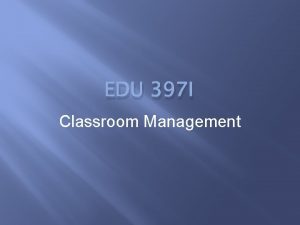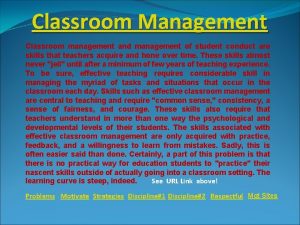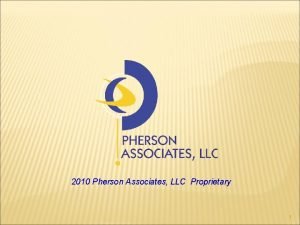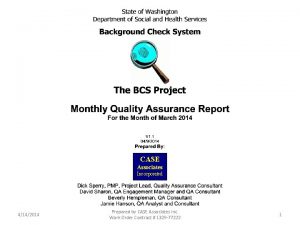Reach Associates Successful Classroom Management To copy or



































- Slides: 35

Reach Associates: Successful Classroom Management To copy or adapt this material, see Opportunity. Culture. org/terms-of-use 2019 |

Welcome! • Introduce facilitators • Participant icebreaker ü Name ü School and grade level/content they will support ü One word to describe how they are feeling about new role • Schedule and session topics 2019 | 2

Do Now Directions: Take 1 minute to write down a challenge in classroom management you have had in the past and what you did to try to solve this problem. Time for this activity: 1 minute 2019 | 3

Session Objectives • Learn powerful approaches to classroom management. • Practice applying the behavior management cycle—how to set and reinforce expectations for behavior, use effective praise to narrate the positive, and use consequences to manage behavior. 2019 | 4

Classroom Management in Action See Handout 2019 | 5

Ideal Situation What does successful classroom management look like? • Students are consistently on task and engaged throughout the lesson • Teachers address most misbehaviors quickly and efficiently with correction • Students bounce back quickly with a positive attitude and minimal to no resistance Adapted from Match Education’s The Kraken Evaluation Rubric 2019 | 6

Behavior Management Cycle “_______, the expectation was to be at a voice level 0. This is your verbal warning. ” 3. Take corrective action 1. Set and reinforce expectations 2. Use positive narration See Handout “Let’s all come back together with eyes on me, pencils down, and at a voice level 0. ” “____ is at a voice level 0, patiently awaiting directions. ” 2019 | 7

Behavior Management Cycle Think-Pair-Share • Individually, reflect: 3. Take corrective action 1. Set and reinforce expectations 2. Use positive narration ₋ What are your reactions to this cycle? ₋ What would come naturally? ₋ What would need practice? • Share reflections with a partner (2 min) • Debrief full group Time for this activity: 2 minutes 2019 | 8

Step 1: Set and Reinforce Expectations 2019 | 9

Activity 1: Procedures What common routines or procedures have you used (or would you use) with students? Common examples: • Entering and exiting the classroom • Walking down the hallway • Transitioning to the carpet • Turning in homework • Looking up for instructions while at computers Procedures Directions Choose 1 procedure and write down everything students must do to complete that procedure. Narration Corrective Action 2019 | 10

Giving Directions: A Non-Example 2019 | 11

Giving Clear Directions What are some characteristics of clear, strong directions? • Steps • Time limits • Check understanding • Formal, calm tone • Visual or non-verbal cues • Positive List adapted from Math Education’s “Match Minis” and Doug Lemov’s Teach Like a Champion 2019 | 12

Giving Clear Directions Do? Move? Talk? Time? See Handout What should students do? Answer questions #10 -15? Work in small groups? Walk in a straight line to lunch? Stop working and put pencil down? How should students move? Stand? Sit? Walk? Should students be talking? How loud? To whom? How long should students take? Adapted from No-Nonsense Nurturer’s MVP Directions © 2015 CT 3; For more information see http: //www. ct 3 education. com/no-nonsense-nurturer/ or hear real teacher voices at http: //www. ct 3 education. com/2015/07/29/im-a-better-teacher-now-than-ive-ever-been/ and http: //www. ct 3 education. com/2015/07/25/others-mock-what-they-dont-understand/ 2019 | 13

Giving Clear Directions “Now that we have finished that activity, please bring your book to the reading carpet. ” Do? Move? Talk? Time? “Now that we have finished that activity, let’s move to small-group reading. When I say ‘GO’, you have one minute to silently grab your reading book, walk over to your assigned carpet seat, and open to Chapter 2. GO!” Adapted from No-Nonsense Nurturer’s MVP Directions © 2015 CT 3; For more information see http: //www. ct 3 education. com/no-nonsense-nurturer/ 2019 | 14

Activity 2: Directions Using your procedure from earlier: • Write a set of clear directions that you could say to students to set them up for success in your procedure. • Include all components: Do? Move? Talk? Time? • Prepare to role-play your directions. • Role-play your directions with a partner. • Give each other feedback on your directions. Procedures Directions Narration Corrective Action 2019 | 15

Step 2: Use Positive Narration 2019 | 16

Two Scenarios “Thank you for your insightful reflections! Now we are going to move to independent reading time. Please take out your books, turn to Chapter 2, and begin reading silently at your seat. [Slight pause. ] Everyone at Table 4 is taking out their books silently. [Slight pause. ] I can see that Sam is making a connection to the text because he is writing in the margin. ” “Thank you for your insightful reflections! Now we are going to move to independent reading time. Please take out your books, turn to Chapter 2, and begin reading silently at your seat. [Slight pause. ] Jenny, the directions were to be silent. This is your second infraction; please move your seat and complete the behavior reflection. ” 2019 | 17

Definition of Behavior Narration “Effective narration begins with teachers giving clear, step-by-step directions. After giving directions, teachers identify individuals or groups who are following the instructions and briefly describe their actions to the class. ” http: //www. schoolimprovement. com/classroom-management-narrating-positive-behavior/ 2019 | 18

Narrate the Positive Why does behavior narration help? • • Stresses your expectations are important Respects student autonomy and builds self-control Reminds and redirects students in a positive and productive way Causes the adult to first think about the positive over the negative http: //www. ct 3 education. com/2015/08/05/the-power-of-positive-narration/ 2019 | 19

Do It: Narrate Using your procedure and directions: • Practice role-playing your directions again with a partner. • Immediately following your directions, narrate 2 -3 “students” by: • Identifying individuals or groups of students who are following instructions. • Briefly describe their actions to the class. • Give each other feedback on your directions and narration. Procedures Directions Narration Corrective Action 2019 | 20

Step 3: Take Corrective Action 2019 | 21

Unpacking Why Students Misbehave Why do students typically misbehave? • Lack of scaffolding the content; the content isn’t rigorous enough • Lack of clarity in directions or expectations • Inconsistent enforcement of rules and expectations • Lack of relationship-building for a foundation of trust, respect, and love • Personal student issues (such as having a hard day, family challenges, etc. ) • Severe behavioral challenges 2019 | 22

Think-Pair-Share How can you try to prevent behavior issues instead of being reactive? Time for this activity: 3 minutes 2019 | 23

Reacting to Misbehaviors What are the main takeaways from this video? Video source: Match Education’s “Match Minis” 2019 | 24

Implementing Consequences Effectively • Restate directions and use a consequence choice • Remain calm, move on quickly, and do not engage in a back-and-forth in the moment • Check in later with a student who becomes upset • Respond to misbehaviors quickly—within 10– 20 seconds • Repeat narration and corrective action parts of the cycle if class is still not fully meeting expectations • Develop system within the entire teaching team to address major incidents 2019 | 25

Team Discussion What is the consequence hierarchy in your school, team, or classroom? 2019 | 26

Activity 4: Corrective Action Using your procedure and directions: • Practice role-playing your directions again with a partner • Narrate 2– 3 “students” • Give a “misbehaving student” a consequence that is aligned to your consequence hierarchy just discussed • Give each other feedback on your directions, narration, and consequence Procedures Directions Narration Sample Hierarchy: 1. Verbal Warning 2. Seat Change and Behavior Reflection 3. Call Home 4. Removal from Class Corrective Action 2019 | 27

Closing Reflections • Take another look at the challenge you wrote down for your Do Now. • Based on what you have learned today: • How would you have approached the challenge differently? • How could you have prevented the challenge from occurring? 2019 | 28

Action Steps Write down and share a few next steps you commit to incorporating into your work based on your takeaways from this session. Next Steps By Whom By When Meet with my MCL or TRT to discuss and plan common procedures and expectations. MCL or TRT ASAP Script out and practice clear directions for common procedures and expectations. Before first day of school Practice positive behavior narration. Ongoing Find out my school’s consequence hierarchy (and/or PBIS* plan) or process for addressing student behavior. Before first day of school Notes/Resources *Positive Behavior Interventions and Supports 2019 | 29

1 Sources Content was adapted from: • Canter, L. & Canter, M. Assertive Discipline: Positive Behavior Management for Today’s Classroom, 1992; Canter, 2009 • No-Nonsense Nurturer’s MVP Directions © 2015 CT 3 • Marzano, R. Classroom Instruction that Works, 2001 • Match Education’s “Match Minis” • Teaching As Leadership, Teach For America 2019 | 30

Appendices 2019 | 31

Proactive Management Mentality Turn and Talk: • What does a proactive managementality mean to you? Video source: Match Education’s “Match Mini’s” 2019 | 32

Proactive Management Mentality What are the key elements of a proactive managementality? • Assert authority with student in a firm and positive manner • Goal for management must be 100% • Work with TRT, MCL, or team teachers to create a list of a limited number of non-negotiable rules (3– 5) that are clearly stated in the positive • List your nonnegotiables, make expectations clear to students, plan reminders, make students feel noticed • Teach expectations for each rule 2019 | 33

Reinforce Good Behavior What are some other ways your school or your team incentivizes good student or class behavior? • Example: Class point system • When 100% of the class meets the expectation OR when students go above and beyond the expectation, the whole class gets a point. • After x number of points, the class gets a mutually agreedupon incentive (such as no assigned seats for a class period). • After giving directions, the teacher might say, “La. Juan has silently started her Do Now. . . We have 100% of the class working productively and silently on the Do Now. You have earned a class point. ” 2019 | 34

Follow Us! Keep up to date on Opportunity Culture with resources and research from Public Impact by following: @Public. Impact @Opp. Culture Facebook. com/Public. Impact Facebook. com/Opportunity. Culture Linked. In. com/company/public-impact---chapel-hill-nc Subscribe to the quarterly Opportunity Culture newsletters, with content by and for Opportunity Culture educators, and sign up to get Remind messages for them: Opportunity. Culture. org/mailing-list/ Remind. com/join/ocnew 2019 | 35
 Reach associates
Reach associates Culturally responsive teaching self assessment
Culturally responsive teaching self assessment Reach associates
Reach associates Reach associates
Reach associates Smart classroom vs traditional classroom
Smart classroom vs traditional classroom Project selection and portfolio management
Project selection and portfolio management Successful stuttering management program
Successful stuttering management program Ibm virtual data pipeline
Ibm virtual data pipeline Ripple effect in teaching
Ripple effect in teaching Diana browning wright
Diana browning wright 17 proactive classroom management strategies
17 proactive classroom management strategies Diana browning
Diana browning Wayne resa pbis
Wayne resa pbis Learning and development plan for teachers
Learning and development plan for teachers Key elements of classroom management
Key elements of classroom management Thrust classroom management
Thrust classroom management Kounin overlapping
Kounin overlapping Comprehensive classroom management
Comprehensive classroom management Ginott model of classroom discipline
Ginott model of classroom discipline Rote discipline meaning
Rote discipline meaning Dimension of classroom management
Dimension of classroom management Permissive approach
Permissive approach Champs behavior plan
Champs behavior plan Synchroneyes classroom management software
Synchroneyes classroom management software Jones theory of classroom management
Jones theory of classroom management Classroom netop vision pro
Classroom netop vision pro Fred jones theorist
Fred jones theorist Overlapping in classroom management
Overlapping in classroom management Overlapping in classroom management
Overlapping in classroom management Dreikurs classroom management theory
Dreikurs classroom management theory Classroom management mid year
Classroom management mid year With-it-ness classroom management
With-it-ness classroom management Group managerial approach in classroom management
Group managerial approach in classroom management Classroom management meaning
Classroom management meaning Champs classroom management powerpoint
Champs classroom management powerpoint Alfie khon
Alfie khon



